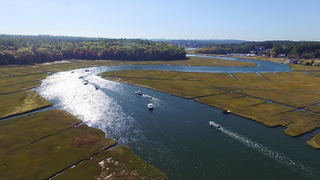UMass Amherst’s Erin Peck: Examining Survival of US Coastal Salt Marshes Beyond River Sediment for Rising Seas Impact
Building up coastal U.S. wetlands that are drowning under rising oceans remains a challenge, but scientists are now one step closer to identifying solutions, thanks, in part, to UMass Amherst postdoctoral researcher Erin Peck’s co-authored work, which appeared recently in the journal Science.
Erin Peck grinding salt marsh sediment in order to measure sediment contributions from rivers. Credit: Sophia Wensman
“We know that river sediment is crucial for helping coastal salt marshes keep their heads above water,” says Peck, who is a postdoctoral researcher at the Northeast Climate Adaptation Science Center at UMass Amherst and a member of Jon Woodruff’s Sedimentology and Coastal Hazards Group. “We also know that vegetation in salt marshes is likewise responsible for increasing the height of salt marshes. But until know, we haven’t known which of these contributes most to keeping the salt marshes viable.”
It turns out that river sediment alone cannot keep salt marshes viable in most of the U.S. in the era of climate change.
Peck and her co-authors, including lead author Scott Ensign, of the Stroud Water Research Center, a nonprofit that studies freshwater streams and rivers around the world, and Joanne N. Halls, professor of earth and ocean sciences at the University of North Carolina Wilmington, analyzed nearly 5,000 rivers across the U.S. and found that almost three out of every four could not deliver enough sediment to match sea-level rise in their connected coastal areas. Nearly half fell short of the amount of sediment needed by at least tenfold.
The exception to this rule is that rivers on the West Coast, where marshes are smaller and the rivers flow down steeper terrain with fewer sediment-stealing floodplains along the way, do seem to provide enough sediment to keep their salt marshes healthy.
What is surprising about all this is that, so far, many salt-marshes around the U.S. are able to keep up with sea-level rise. “The numbers don’t add up,” says Ensign.
This means that some other factor in addition to riverine sediment is helping to build them up.
Salt marshes are important for helping to protect the world’s human population, much of which lives on the coasts, from storm surges. They help filter water and provide critical habitat for many plants and animals.
One of the main strategies for helping salt marshes survive has been the removal of upstream, sediment-blocking dams. “While dam removal remains an important tool in getting sediment to the embattled marshes,” Peck says, “it’s not going to be enough.”
“Across the board, the most important action for saving tidal wetlands is to allow them to migrate upslope,” says Ensign. “In some areas, this will require restoring natural hydrology and preserving low-lying land. Direct application of sediment and other engineering approaches can also be useful at very local scales.”
The complete article, “Watershed sediment cannot offset sea level rise in most US tidal wetlands,” is available online from Science.

